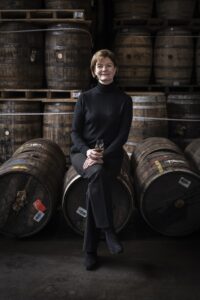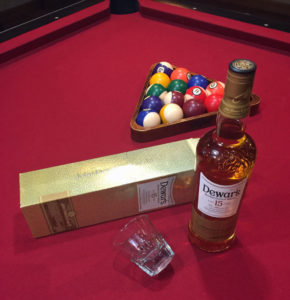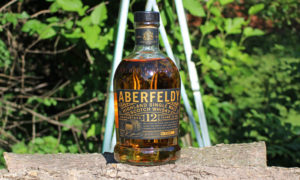By Richard Thomas
I observed a few years back that whisk(e)y enthusiasts were living in a time of the changing of the guard, when well-established whiskey-makers were retiring from long-held posts. The best examples of this lately were in 2020, with Chris Fletcher succeeding as Master Distiller at Jack Daniel’s and Kevin O’Gorman rising from Master of Maturation to Master Distiller at New Midleton.
However, in the midst of all this changing of the guard, another class of whiskey-makers have grown into the new giants of their industry, the fixtures that should be well-known names among enthusiasts. That is especially so when one realizes that, nowadays, anyone who has been a big company Master Blender or Master Distiller for 10 or 15 years has had a hand on the tiller of one or more whiskey brands for the duration of the world whiskey boom. In an early indicator of the current day, many of them are women. That brings us to Stephanie Macleod, Master Blender at Dewar’s and its associated family of single malts.
It’s been a busy year for Dewar’s, so it looked like a good time to check in with Macleod about what is going on today and to look back on her tenure.
RT: You took over as Master Blender at Dewar’s in 2006, so your tenure encompasses basically the whole of the modern whisky boom times. Just how many Dewar’s whiskies have you created in that time?
SM: You’re right, we’ve been very busy at Dewar’s. For the Blended Scotches we’ve launched around 30 new expressions, and if you include all the single malts too, it’s well over 100, probably nearer 200 now with our Single Malts ‘Exceptional Cask’ range and the Limited Editions.
RT: And of them, which creation are you fondest of?
SM: Dewar’s 15 was my first project, so that one is closest to my heart, however, Double Double 32 is a four-times award winner at the International Whisky Competition, and made me 4 times Master Blender of the Year – so I’m very fond of that one too! There is a Dewar’s whisky for every occasion, and there’s a cocktail for every Dewar’s whisky – I always say that Dewar’s is made to be savored and enjoyed how you want to drink it – there’s no prescribed ceremony – it’s your Dewar’s, enjoy it!
RT: Dewar’s is quite popular here in the States. I think the rule is that in any given year, it is either the top-selling Scotch Whisky or just slightly behind Johnnie Walker, and it’s been big in America since before Prohibition. So, for the Americans, what sets Dewar’s White Label apart from its peers?
SM: I love visiting the US, and so it makes me very proud that Dewar’s has maintained its position in the hearts of US whisky appreciators. Dewar’s has a rich history and a complex and distinctive flavor that holds it character over ice or in a cocktail and I think that’s what makes it distinctive from other whiskies with Americans.
RT: Dewar’s owns Aberfeldy, Aultmore, Craigellachie, Macduff and Royal Brackla, each a distillery and a malt with its own unique flavor profile. How do these malts contribute to the Dewar’s flavor profile?
SM: Aberfeldy, Aultmore, Craigellachie, Royal Brackla and Macduff/Glen Deveron are all much sought after Single Malts.
Aberfeldy is a Highland Malt – which is rich and complex with notes of honey, fruits notes and a citrus twist; Aultmore is a Speyside Malt and it’s typical of that region – it has an ethereal quality – with soft notes of fruit, freshened with herbal and green notes; Craigellachie is also a Speyside – but it is not a typical Speyside – it is made in the very traditional way of using Worm Tubs as the condensers, and so it retains a muscular quality and with age exotic notes of pineapple emerge, but always bolstered by the complex muscularity of this whisky; Royal Brackla is a Highland Malt – I describe it as ‘Summer in a glass’ it’s vibrant and elegant with green, floral and fruity notes; Glen Deveron which is distilled at Macduff Distillery is also a Highland Malt with beautiful toasted cereal notes and baked apples.
RT: Totally off-topic, self-indugent question here: I’ve heard you did some sensory science work on olive oil back in the day? I’m an azeite nerd; please, do tell me all about it.
SM: My goodness it was a long time ago – but we were trying to compile a flavor map of olive oils, so we had Italian olive oils and also a Spanish one, which had a distinctive aroma of peaches – it was awesome!
RT: Onto new stuff. I understand Dewar’s is bringing out a new, reformulated version of the 12 Year Old. It replaces the version created by your predecessor, Tom Aitken. What has changed?
SM: Dewar’s 12, I must stress uses the same recipe since it was introduced in 2000 that has not changed! All Dewar’s Blends are Double Aged – which means that once all of the malt and grain whiskies come of age and we blend them together, instead of sending it for bottling we take the blend and fill it into specially selected oak casks to allow the disparate flavor properties of the different malts and grains to interact with one another, providing a smoothing effect. The cask we use have no more maturation potential to yield. However, for the refresh of Dewar’s 12 – instead of Double Aging in the typical casks we now use 1st fill Bourbon casks – which has bestowed on Dewar’s 12 more creamy caramel notes and more citrus zest – making it even more approachable.
RT: My misunderstanding there. But you also have another release in the Casks Series coming out, French Smooth. This one is finished in Calvados casks. How much experimentation goes into arriving at the cask selections for this series?
SM: Dewar’s 8, French Smooth is outstandingly beautiful – it’s finished in Calvados casks; Calvados is a French apple brandy, and its character remaining in the casks, works incredibly well with our Dewar’s 8. When we want to use a new type of cask, quite often I’ll get that particular spirit or wine, and pour some into a glass, swirl it and then empty it, then pour the whisky in – if they compliment each other at that stage then we’ll source the casks. Once the casks arrive, we nose each one and then once filled we’ll assess monthly or more in order to ensure that the characteristics of the finishing cask don’t dominate the flavor of the whisky.
 The Whiskey Reviewer A World of Whiskey, Poured Every Weekday
The Whiskey Reviewer A World of Whiskey, Poured Every Weekday



